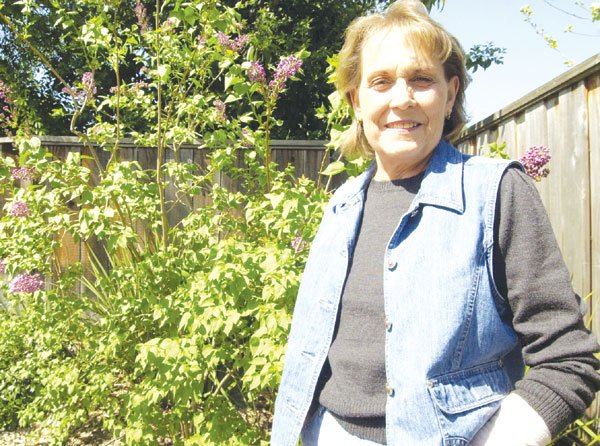GILROY
– Pam Robb received an unexpected phone call last month that
many wait for their entire lives.
She had won the lottery. But instead of money, Robb would be
getting something that, for her, was even more precious: a
kidney.
GILROY – Pam Robb received an unexpected phone call last month that many wait for their entire lives.
She had won the lottery. But instead of money, Robb would be getting something that, for her, was even more precious: a kidney.
Just two months after joining the list of potential kidney transplant recipients, Robb learned her perfect match had arrived. A month after the transplant, Robb is still peeling back the “layers of miracles” and adjusting to her newfound freedom.
The fact that the kidney came on the 24th anniversary of the day Robb started dialysis is just too coincidental, she says.
“Everything else is just so amazing and so much of a miracle, and then to put that on top of it all, I just say, ‘God has a sense of humor,’ ” Robb said. “It couldn’t have been improved upon, how I got it. Two months on the list, a perfect match …”
The precise reason for Robb’s kidney failure is still not known, but the petite 55-year-old had no intention of pursuing a transplant when she started dialysis on Feb. 24, 1980. While her children – Emily, 22, and Andrew, 19 – were growing up, Robb and her doctors decided it would be safer to stay on dialysis.
“A transplant is not a cure, a transplant is another treatment,” the Gilroy resident of 27 years said. “The risk of death with a transplant is far greater than with dialysis.”
As she got older, Robb began to consider adding her name to the transplant waiting list. Since the doctors predicted the wait would be five to seven years, she decided to begin the necessary tests and was added to the bottom of the list last December.
An asterisk accompanied her name because she had yet to complete a required physical test, she said. The test was scheduled for Thursday, Feb. 26. Packets and brochures on kidney transplant procedures provided by her doctors remained unread because Robb “had plenty of time to get around to it.”
Two days before the test, at midnight on Tuesday, Feb. 24, she got the phone call that she describes as “mind-numbing.” A kidney was available that suited Robb better than anyone else on the list.
Robb and her husband, Gilroy High School Choir Director Phil Robb, were at Stanford Hospital by 6 a.m.
“The initial thing was a little overwhelming when we got the phone call because we never anticipated something like this happening now,” Phil Robb said. “And as I started to understand it, I realized that there was no other option. This was an incredible gift that you just couldn’t turn down.”
Besides being a perfect match, the kidney – from a 17-year-old Arizona resident – came from a brain-dead patient, meaning it was a living organ when harvested. It was on ice for only eight hours.
“Even if I had gotten to the top of the list, I might not have gotten a perfect match,” Robb said.
Still, nothing was certain until the moment she was wheeled to the operating room because doctors had to gauge the organ first.
More miracles
The hardest part about her six-day stay in the hospital, Robb says, was the 20 pounds of fluid filling her body that killed her appetite and made her nauseous.
“Dehydration is, just, death to the kidney,” she said. “So, they pumped all this fluid into me.”
The first few days back at home were difficult, as well, particularly without the convenience of a hospital bed.
But more miracles were coming. She was greeted by three solid weeks of beautiful, sunny days, with record-setting temperatures that reached into the upper 80s.
Another miracle, Robb says, was her daughter’s homecoming from Pennsylvania four days before her unexpected transplant. Phil Robb had gone to Pennsylvania and driven Emily back across the country to take a job in the Bay Area.
Their two children played a big part in Robb’s recovery – Emily for her organizational skills that kept the house running and Andrew for much of the legwork.
“It was a little depressing to see her so groggy,” said Andrew Robb, who also found some humor in the situation. “Her feet were like big pillows.”
Thankfully, Robb had a bell to ring and three family members at her beck-and-call.
“That bell was really annoying,” her son said.
Both Pam and Phil say they remain “overwhelmed” by the experience.
Upon hearing news of the available kidney and preparing for the transplant, Phil was able to keep himself together, until he called his wife’s father to tell him the news.
“And that’s when I lost it,” he said. “Mainly because he lost it, and that was just one of those emotional moments. And I earned it, so it was great.”
Now, Robb is planning a vacation up the Pacific Coast for herself and her husband, something she never felt the freedom to do before. Scheduling dialysis appointments three months in advance and then putting vacation time on hold to do the procedure were inconveniences that kept her from traveling for years.
She also is learning to live without dialysis – a two-and-a-half-hour process completed at Stanford Hospital three times every week, for nearly half her life. Dialysis was a “lifestyle,” she says, and her newfound freedom is just starting to set in, particularly when it comes to her diet.
Newfound freedom
“I can eat anything I want now,” Robb said.
It will take time to adjust, however. Since all food and drink must be processed by the kidneys, Robb spent 24 years limiting her water intake and avoiding high potassium fruits and vegetables.
She now relishes eating a banana every morning.
“I was a model dialysis patient,” she said. “Whenever I drank anything for 24 years, I always took the smallest glass, but now they’re saying, ‘Pick the largest glass’. It’s almost something you can’t do overnight, you almost have to learn.”
As with any transplant, the risk of organ rejection will remain a reality for at least two more months. Several times daily, Robb checks her blood pressure, temperature and weight. She must make sure her body is still accepting the new kidney that sits in the front of her abdomen, tucked under her pelvic bone on the right side. It’s more accessible for ultrasounds and biopsies there.
A private woman, Robb didn’t tell many people about her dialysis treatments because she didn’t want it to control her life. Now, she feels compelled to share her tale of miracles upon miracles and is taken aback by the outpouring of help from those who hear it.
“The community support has just been phenomenal,” Robb said.
Throughout the past month, loyal friends, GHS parents and fellow members of Advent Lutheran Church in Morgan Hill have delivered dinners on a daily basis. Robb, a former teacher and longtime homemaker, was thrilled Tuesday night to cook dinner again for the first time since the transplant.
“I don’t know what people would do without the support here in town,” her husband said.













